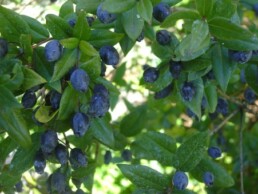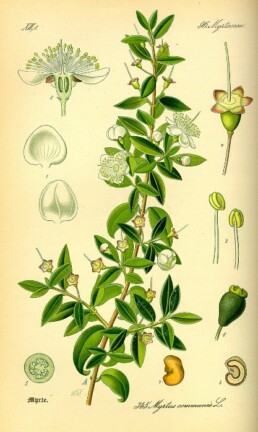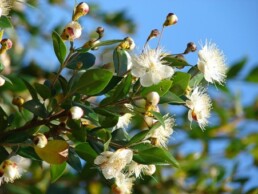10 – Myrtus communis / Common Myrtle
If you pardon the pun this one stumped me a little, because depending on where it grows it could be described as a woody plant, and therefore in my view not a tree, but it was significant enough for God to instruct His people to use its branches in an act of remembrance (mitzvah) or Feast of Tabernacles which is still done today among the Jewish people. So here goes.
Myrtus communis, Common Myrtle
Well known in biblical times, native across the Mediterranean region, Macaronesia, western Asia, and the Indian subcontinent, and known to horticulture for centuries it was not until 2010 that the RHS decided to recognise it with an Award of Garden Merit.
The plant is an evergreen shrub or small tree, growing 16 ft tall. Leaves are 2 ins. long and smell divine when crushed. Copious white flowers cover the branches attracting pollinators in long dry summers, that will produce blue-black fruits for birds to disperse in the Autumn.
A sprig of myrtle from Queen Victoria’s wedding Bouquet was planted as a slip at Osbourne House Isle of Wight which grew successfully, and since then foliage has been used in every Royal Wedding bouquet since.
The tree is first mentioned in the book of Leviticus as part of Jewish law where they are instructed by God through Moses to remember their wanderings through the dessert because of their disobedience. Lev 23 v 40 Being an evergreen and a tree of great fragrance and blossom, it speaks of hope, promise, and new beginnings. The whole nation of Israel wandered in the desert for 40 years until all of those who had worshiped the golden calf they had built from their jewellery while Moses was receiving the ten commandments had breathed their last, and lived in tents (tabernacles) they had to remember this.
We come across the myrtle next in prophetic book of Isaiah in Ch 41 v 19, and 55 v 13 where God himself plants myrtles in the wilderness and replaces briars with them He thinks of them so highly within his creation. Next, we come across them again in Neh. 8 v 15 when Ezra read out the Torah the Levitical law I mentioned earlier, about ritual and where they had come from and God had blessed them. Lastly it is mentioned within Zechariah’s prophetic visions in Ch 1 v 8, 10 – 11, where the angel of God is on a red horse among myrtle trees.
It is clear to me that the common myrtle signifies blessing of enormous proportions and that our relationship with God and its condition should never be forgotten either. Using a little bit of poetic licence here but I’m not sure if you heard St Pauls Cathedral the only place of worship not to be affected in any by the London blitz in WW2 have opened an online book of remembrance for all those who have lost their lives in this pandemic, which is now approaching 40,000. Due to Covid 19 many people across generations have been unable to say goodbye to loved ones. Quite interesting that myrtle foliage is used in Royal Wedding Bouquets since 1840 and will continue to be so and our monarchs are deemed Heads of the Church since the Reformation. A fitting act of remembrance then for the established church. So is Mitzvah for Israel and so is Breaking of Bread for us Christians. But can we honestly say we know God intimately enough, to be as evergreen as HE wants us to be, to blossom within this pandemic as brightly as HE desires, and, to be used for our Feast of Tabernacles for now and for future generations.





